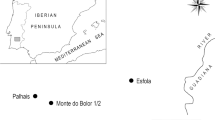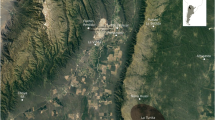Abstract
In this work, five unique Iberian Iron Age handles have been studied. The use of portable X-ray fluorescence (pXRF) and Fourier transform near–infrared (FT-NIR) spectroscopy no-destructive techniques has allowed us to identify two raw materials (amber and tin) used to decorate the ivory handles. Due to the finesse of their inlaid decoration and the value and exoticism of the material employed for their manufacture, these ivory objects are really exceptional Iberian archaeology findings. Interestingly, it has been possible to determine that tin was used as an adherent material to fix the inlaid small pieces of amber in the handles. The obtained results allow the better understanding of the manufacturing processes, areas of production, and accessibility to exotic materials of valuable objects during the Iberian period.













Similar content being viewed by others
References
Álvarez-Fernández E, Peñalver E, Declòs X (2005) La presencia de ámbar en los yacimientos prehistóricos (del Paleolítico Superior a la Edad del Bronce) de la Cornisa Cantábrica y sus fuentes de aprovisionamiento. Zephyrus 58:147–170
Asderaki-Tzoumerkioti E (2008) Ancient and modern joining techniques on a bronze Hellenistic urn. In: Ambers J, Higgitt C, Harrison L, Saunders D (eds) Holding it all together: ancient and moderns approaches to joining, repair and consolidation. Archetype Publications - The British Museum, London, pp 173–176
Averbouch A, Provenzano N (1998-1999) Proposition pour une terminologie du travail préhistorique des matières osseusses: 1.-Les techniques. Préhistorie et Anthropologie Méditerranéenes 7:1–28
Barrachina A (2012) Indesinenter: Permanencia y cambio. El Pic dels Corbs como modelo de interpretación de la edad del bronce en el norte del País Valenciano. Serie de Prehistòria i Arqueologia, Castellón
de la Bandera ML (1986) Introducción al estudio de la joyería prerromana peninsular. Técnicas Habis 17:515–538
Blasco-Martín M (2015) El trabajo sobre hueso, asta y marfil en Covalta. Evidencias de un taller de época ibérica. Recerques del Museu d’Alcoi 24:43–58
Bonet-Rosado H, Mata-Parreño C (2002) El Puntal dels Llops. Un fortín edetano. Serie de Trabajos Varios 99, Valencia
Bonet-Rosado H, Mata-Parreño C (2014) Who lives there? Settlements, houses and households. In: Knapp AB, Van Dommelen P (eds) The Cambridge prehistory of the Bronze and Iron Age Mediterranean. Cambridge University Press, pp 471–487. https://doi.org/10.1017/CHO9781139028387.034
Camps-Fabrer H (dir) (1974) Premier colloque International sur l’Industrie de l’os dans la Préhistoire. Université de Provence, Vaucluse
Camps-Fabrer H (dir) (1979) L’industrie en os et en bois de cervidé_durant le Néolithique et l’Âge des Métaux: première réunion du groupe de travail n° 3 sur l’industrie de l’os préhistorique. Centre National de la Recherche Scientifique. Paris
Cascant MM, Rubio S, Gallello G, Pastor A, Garrigues S, de la Guardia M (2017) Burned bones forensic investigations employing near infrared spectroscopy. Vib Spectrosc 90:21–30. https://doi.org/10.1016/j.vibspec.2017.02.005
Caubet A, Gaborit-Chopin D (2004) Ivoires: de l’Orient Ancient aux temps modernes, Paris
Causey F, Maish J, Khanjian H, Schilling MR (2012) Ancient carved ambers in the J. Paul Getty Museum. J. Paul Getty Museum. http://museumcatalogues.getty.edu/amber/contents. Accessed 23 July 2017
Cuadrado E (1957) La fíbula anular hispánica y sus problemas. Zephyrus 8:5–57
Cuadrado E (1987) La necrópolis ibérica de El Cigarralejo (Mula, Murcia). Bibliotheca Praehistorica Hispana XXIII, Madrid
Edwards HG, Villar SEJ, Hassan NFN, Arya N, O’Connor S, Charlton DM (2005) Ancient biodeterioration: an FT–Raman spectroscopic study of mammoth and elephant ivory. Anal Bioanal Chem 383:713–720. https://doi.org/10.1007/s00216-005-0011-z
Fernández Flores A, Rodríguez Azoque A, Casado Ariza M, Prados Pérez E (coords) (2014) La necrópolis de época tartésica de la Angorrilla, Alcalá del Río, Sevilla. Universidad de Sevilla, Sevilla
Formigli E (2004) El uso de estaño con ámbar para obtener un efecto de color similar al oro en la orfebrería etrusca. In: Perea A, Montero I, García-Vuelta O (eds) Ancient gold technology: America and Europe. Anejos de AESPA XXXII, CSIC, Madrid, pp 91–96
Gallello G, Ghorbani S, Ghorbani S, Pastor A, de la Guardia M (2016) Non-destructive analytical methods to study the conservation state of Apadana Hall of Persepolis. Sci Total Environ 544:291–298. https://doi.org/10.1016/j.scitotenv.2015.11.156
Gallello G, Ramacciotti M, Lezzerini M, Hernandez E, Calvo M, Morales A, Pastor A, de la Guardia M (2017) Indirect chronology method employing rare earth elements to identify Sagunto Castle mortar construction periods. Microchem J 132:251–261. https://doi.org/10.1016/j.microc.2017.02.009
García Cano JM (1997) Las necrópolis ibéricas de Coimbra del Barranco Ancho (Jumilla. Murcia). I. Las excavaciones y estudio analítico de los materiales. Universidad de Murcia, Murcia
García Cano JM, Page V, Ramos F, Hernández E, Gil F (2008) El mundo funerario ibérico en el altiplano ibérico en el altiplano Jumilla-Yecla (Murcia): La necrópolis de El Poblado de Coimbra del Barraco Ancho. Investigaciones de 1995–2004. II.-Las incineraciones y los ajuares funerarios. Proyecto Iberos Murcia, Murcia
García-Puchol O, McClure SB, Juan-Cabanilles J, Pascual-Benito JL, Gibaja Bao JF (2012) Objetos singulares/Objetos foráneos. Evidencias de circulación de artesanías en el depósito funerario del Neolítico Final/Calcolítico de la Cova de la Pastora (Alcoi, Alacant). Rubricatum. Revista del Museu de Gavà 5:281–288
Grau I (1996) Estudio de las excavaciones antiguas de 1953 y 1956 en el poblado ibérico de La Serreta. Recerques del Museu d’Alcoi 5:83–119
Grau I, Reig C (2002-2003) Sobre el uso de metales en la Contestania Ibérica: las evidencias de La Serreta. Recerques del Museu d’Alcoi 11-12:101–150
Iniesta A, Page V, García Cano JM (1987) Coimbra del Barranco Ancho I: La Sepultura 70 de la necrópolis del Poblado. Murcia
Ishikawa T, Wakamura M, Kondo S (1989) Surface characterization of calcium hydroxylapatite by Fourier transform infrared spectroscopy. Langmuir 5:140–144
Macgregor A (1985) Bone, antler, ivory & horn: the technology of skeletal materials since the roman period. Croom Held, London & Sidney
Mata-Parreño C, Soria-Combadiera L, Blasco-Martín M, Fuentes-Albero M, Collado-Mataix E (2017) Peines de marfil y madera de la II Edad del Hierro en la Península ibérica. talleres, estilos y otros enredos. Complutum 28(1):141–165
Mata-Parreño C, Soria-Combadiera L, Blasco-Martín M, Fuentes-Albero M, Fuertes-Cabo I, Collado-Mataix E (2018) Raw material, gestures, objects. An approach to the work of bone and ivory in the iron age in the Iberian Peninsula. Quat Int 472:115–125. https://doi.org/10.1016/j.quaint.2017.11.045
Mazuy A, Rodet-Belarbi I, Rageot M, Regert M (2014) Du brai de bouleau sur des éléments de charnière gallo-romains à Fréjus (Var, France). Instrumentum 40:25–28
Molist N, Rovira J (1986–1989) L’oppidum ausetà del Turó del Montgròs (El Brull, Osona). Empúries 48–50 (II):122–141
Muller K, Reiche I (2011) Differentiation of archaeological ivory and bone materials by micro-PIXE/PIGE with emphasis on two Upper Palaeolithic key sites: Abri Pataud and Isturitz. France JAS 38:3234–3243. https://doi.org/10.1016/j.jas.2011.06.029
Murillo-Barroso M, Martinón-Torres M (2012) Amber sources and trade in the prehistory of the Iberian Peninsula. EJA 15:187–216. https://doi.org/10.1179/1461957112Y.0000000009
Murillo-Barroso M, García Sanjuán L (2013) El pomo de ámbar de la Estructura 10.042–10.049 del Sector PP4-Montelirio del asentamiento de Valencina de la Concepción (Sevilla). In: García Sanjuán L, Vargas Jiménez JM, Hurtado Pérez V, Ruiz Moreno T, Cruz-Auñón R (eds) El asentamiento de Valencina de la Concepción (Sevilla). Investigación y Tutela en el 150 aniversario del descubrimiento de La Pastora, Universidad de Sevilla, Sevilla, pp 511–519
Mylonas GE (1983) Mycenae rich in gold. Ekdotike Athenon, Athens
Najarro M, Peñalver E, Rosales I, Pérez-de la Fuente R, Daviero-Gómez V, Gómez B, Delclòs X (2009) Unusual concentration of Early Albian arthropod-bearing amber in the Basque-25 Cantabrian Basin (El Soplao, Cantabria, Northern Spain). Palaeoenvironmental and palaeobiological implications Geologica Acta 7 (3):363–387
Navarro R (1970) Las fibulas de Cataluña. Publicaciones Eventuales 16, Universidad de Barcelona, Barcelona
Nocete F, Vargas JM, Schuhmacher TX, Banerjee A, Dindorf W (2013) The ivory workshop of Valencina de la Concepción (Seville, Spain) and the identification of ivory from Asian elephant on the Iberian Peninsula in the first half of the 3rd millennium BC. JAS. 40:1579–1592. https://doi.org/10.1016/j.jas.2012.10.028
O’Connor TP (1984) On the structure, chemistry and decay of bone, antler and ivory. UKIC Archaeology Section Proceedings, United Kingdom
Pallarés F (1965) El poblado ibérico de San Antonio de Calaceite. Instituto Internacional de Estudios Ligures, Barcelona
Paral V, Witter K, Tonar Z (2007) Microscopic examination of ground sections – a simple method for distinguishing between bone and antler? Int J Osteoarchaeol 17:627–634. https://doi.org/10.1002/oa.912
Peñalver E, Álvarez-Fernández E, Arias P, Delclòs X, Ontañón R (2007) Local amber in a Palaeolithic context in Cantabrian Spain: the case of La Garma A. JAS 34:843–849. https://doi.org/10.1016/j.jas.2006.03.006
Perea A, García Vuelta O, Fernández Freire C (2010) El proyecto AU. Estudio arqueométrico de la producción de oro en la península Ibérica. In: Bibliotheca Praehistorica Hispana. XXVII, Madrid
Pérez Ballester J (2006) De la Saitabi ibérica a la Saetabis romana. In: Hermosilla J (dir) História de Xàtiva. Vol. I. Síntesis, Universitat de València, València, pp 137–164
Rijkelijkhuizen MJ, Kootker LM, Davies GR (2015) Multi-isotope analysis of elephant ivory artefacts from Amsterdam: a preliminary provenance study. World Archaeol 47:504–524. https://doi.org/10.1080/00438243.2015.1024884
Rodet-Belarbi I, Van Ossel P (2009) Peignes dans l’Antiquité tardive: os, bois de cerf ou ivoire? Instrumentum 30:33
Rodríguez Díaz A, Pavón Soldevilla I, Duque Espino DM, Ponce de León M, Hunt Ortiz MA, Merideth C (2013) La explotación tartésica de la casiterita entre los ríos Tajo y Guadiana: San Cristóbal de Logrosán (Cáceres). TP 70:95–113. https://doi.org/10.3989/tp.2013.12104
Roth J, Bortolaso G (eds) (2008) Ivory and Species Conservation. Proceedings of INCENTIVS – Meetings (2004–2007), Bundesamt für Naturschutz Skripten. 228, Bonn
Rovira Guardiola R (2005) Las relaciones comerciales entre Hispania y las provincias orientales durante el Alto Imperio Romano. Tesis doctoral, Universidad de Barcelona. http://hdl.handle.net/10803/2589. Accessed 6 August 2017
Rovira i Port J (1994) Ámbar y pasta vítrea. Elementos de prestigio entre el neolítico avanzado y el bronce final del nordeste de la península ibérica Un primer estado de la cuestión Quaderns de Prehistoria i Arqueologia de Castelló 16:67–92
Ruiz Rodríguez A, Molinos M (1998) The archaeology of the Iberians. Cambridge University Press, Cambridge
Schuhmacher TX, Banerjee A (2012) Procedencia e intercambio de marfil en el Calcolítico de la Península Ibérica. Rubricatum: Revista del Museu de Gavà 5:289–298
Schuhmacher TX, Banerjee A, Dindorf W, Sastri C, Sauvage T (2013) The use of sperm whale ivory in Chalcolithic Portugal. TP. 70:185–203. https://doi.org/10.3989/tp.2013.12109
Sciutto G, Prati S, Bonacini I, Oliveri P, Mazzeo R (2014) FT-NIR: an advanced spectroscopic approach for the characterisation of paint cross-sections. Microchem J 112:87–96. https://doi.org/10.1016/j.microc.2013.09.021
Stathopoulou ET, Psycharis V, Chryssikos GD, Gionis V, Theodorou G (2008) Bone diagenesis: new data from infrared spectroscopy and X-ray diffraction. Palaeogeogr Palaeoclimatol Palaeoecol 266:168–174. https://doi.org/10.1016/j.palaeo.2008.03.022
Vera Rodríguez JC (coord) (2014) La Cueva de los Cuarenta (Priego de Córdoba). Avance a los resultados de la Intervención Arqueológica de 2007. Antiquitas 26:71–133
Verdú E (2015) La necrópolis ibérica de l’Albufereta (Alacant). Ritos y usos funerarios en un contexto de interacción cultural. In: Alicante
Vigil Pascual M (1969) El vidrio en el mundo antiguo. CSIC, Madrid
Acknowledgements
The authors acknowledge the collaboration of the staff from the museums where the pieces are deposited (Museu Arqueològic Municipal Camil Visedo de Alcoi, Museo de Arte Ibérico El Cigarralejo de Mula, Museo Arqueológico Municipal Jerónimo Molina de Jumilla y Museu Arqueològic de Catalunya-Barcelona) and all the people that have help us through this paper, especially José Pérez Ballester, director of the excavations of Solana del Castell, for his collaboration and Carmen García Rayo for the English assistance.
Funding
Gianni Gallello acknowledges the financial support of the European Commission (project H2020-MSCA-IF-2015-704709-MATRIX). Agustin Pastor acknowledges the financial support of Generalitat Valenciana (PROMETEO project II/2014/077) and Ministerio de Economia y Competitividad-Feder (project CTQ 2014-52841-P and project CTQ 2012-38635). Consuelo Mata acknowledges the financial support of Generalitat Valenciana (ACOMP2015/256) and Ministerio de Economia y Competitividad (HAR2013-45770-P).
Author information
Authors and Affiliations
Corresponding author
Additional information
Publisher’s note
Springer Nature remains neutral with regard to jurisdictional claims in published maps and institutional affiliations.
Rights and permissions
About this article
Cite this article
Blasco-Martín, M., Gallello, G., Soria-Combadiera, L. et al. Decoration composition of Iberian Iron Age ivory artifacts identified by no-destructive chemical analyses. Archaeol Anthropol Sci 11, 3561–3576 (2019). https://doi.org/10.1007/s12520-018-00775-3
Received:
Accepted:
Published:
Issue Date:
DOI: https://doi.org/10.1007/s12520-018-00775-3




